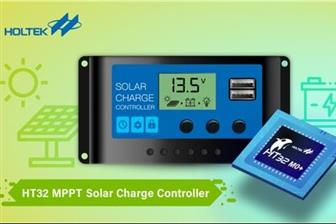Energy conversion has become a crucial topic in the field of global environmental sustainability as a result of global warming and greenhouse effects. Many nations’ economic, trade, and environmental strategies now center on promoting and developing renewable energy. Solar technology development is among the most advanced of the various renewable energy sources now available. The global MPPT PV Solar Energy Charge Controller market is predicted to reach a value of 246 million USD by 2028, representing a compound yearly growth rate (CAGR) of 5.2%, according to a marketsandresearch.biz survey. The market size was estimated to be 173 million USD in 2021.
MCU design experts Holtek Semiconductor are a reputable company. It recently debuted its “MPPT solar charge controller” application solution, with an emphasis on ESG environment sustainable development. This solution’s main controller is an Arm Cortex-M 32-bit MCU, which enables it to maximize the efficiency of sunlight to electrical energy conversion and produce superior energy storage effects.
Systems for generating solar power nowadays use solar panels, controllers, batteries, and related loads. The controller plays a very important function in managing the complete system in all applications. PWM (Pulse Width Modulation) and MPPT (Maximum Power Point Tracking) are two key differences in charge controllers, while MPPT has a greater charging conversion efficiency. With the use of MPPT technology, solar energy conversion may be maximized and stored in batteries. Additionally, it is in charge of implementing protective features, starting and stopping load switching, etc. Three criteria can be used to assess the choice of an MPPT solar charge controller.
Algorithms
The maximum output power of solar panels will be influenced by environmental factors such as the amount of solar radiation that is available and the ambient temperature. An MPPT algorithm that monitors these variables will guarantee that connected goods function at their peak power and achieve the best energy conversion.
Open-circuit voltage, short-circuit current, disturbance observation, and conductivity incremental methods are typically used in mainstream MPPT algorithms. It was determined to use a Holtek Arm Cortex-M0 HT32 MCU at the core of the design for the solar controller employing the MPPT disturbance observation method after undergoing a thorough Holtek examination. In order to alter the voltage magnitude of the following cycle in real time, this method modifies the voltage to observe the current power in the present and compares it to changes in the recent before/after two power values. Repeating this procedure will guarantee that the energy conversion runs at its peak efficiency for the best battery charging.
This solution surpasses the capabilities of the devices on the market today, achieving MPPT efficiency of over 99%.
Types of MCU
With a wide selection of 32-bit MCUs from Holtek, customers can select the most affordable MCU for their MPPT solar charge controller based on the product type, function, and HMI requirements.
A large number of important integrated peripheral IPs are included in the MCU. There are complementary PWM output functionalities for PMOS/NMOS driving that have a programmable dead-time generator to improve and make the charging/discharging circuit operation safer. To increase measurement accuracy, integrated OPAs can be utilized to create noise filter circuits and to amplify current and voltage sampling. Comparator and DAC functions are also included, and these are utilized to implement overcurrent, overvoltage, and other protective features.
The UL/IEC 60730-1 Class B software certification for the HT32 MCUs enables them to offer accurate and comprehensive self-test processes.
Efficiency in conversion and managerial duties
A HT32 microcontroller is used in the design of the MPPT solar charge controller, which includes tracking transient maximum power charging in addition to constant current and constant voltage charging.
The high-frequency DC-DC conversion charging/discharging circuit can give conversion efficiencies as high as 92%, significantly improve charging efficiency, and substantially reduce energy loss.
The MCU main controller intelligently controls the charging and discharging process, lowering the possibility of battery damage and enhancing battery life.
Overall, this solution offers the benefits of smart charging, high MPPT tracking efficiency, high charging conversion efficiency, automatic battery voltage assessment, and a wide range of safety measures. With its variety of characteristics, it is ideally suited to work with different battery types and satisfy the requirements of several connected items.
Additionally, HOLTEK’s highly skilled design team can modify and optimize the customer’s MPPT charging technology applications in accordance with the inherent characteristics of the customer’s energy storage battery. HOLTEK not only offers MPPT solar charge controller solutions using its 32-bit MCU design that can be quickly introduced into volume production. Customers have the option of enhancing the functionality of the application product to include multi-functional solar inverter energy storage box capabilities if they want to use the Holtek application-specific Inverter MCU HT45F5V as well.
solar energy charger HOLTEK HT32 MPPT







